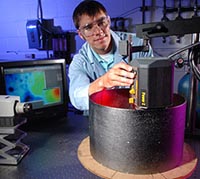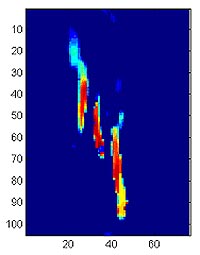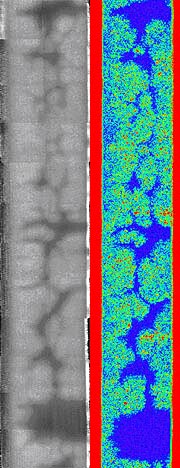Highlights
Inspection technologies protect and enhance materials for power plants

THERMAL IMAGING – Julian Benz uses Argonne’s thermal imaging system with a high-speed infrared camera to detect defects in this ceramic-matrix-composite combustor liner for a gas turbine engine. The images show small air voids – cracks created during manufacture that could cause the part to fail under high operating temperatures.
ARGONNE, Ill. (Aug. 5, 2005) — In modern healthcare, doctors use imaging tools – such as X-ray computed tomography (CT), magnetic resonance and ultrasound – to see beneath the patient's skin without making a single incision. Researchers in Argonne's Energy Technology Division (ET, now Nuclear Engineering Division) are adapting these and other technologies to evaluate critical components of modern energy systems that push the limits to achieve maximum efficiency.
Just as doctors want to avoid harming their patients during routine medical exams, engineers need to evaluate advanced materials without breaking them. Non-destructive evaluation (NDE) tools enable engineers to detect flaws or damage before use in items such as pistons and valves for low-emission diesel engines and turbine blades and combustors for gas turbines. Flawed or damaged components can cause severe damage to engines if the components fail.
ET's mission is to provide solutions to material and engineering problems in energy production. ET's Sensors, Instrumentation and Non-Destructive Evaluation Group supports development of hotter-burning, lower-emission, more efficient gas turbines for electric power generation and helps improve the efficiency of existing nuclear power plants. Both areas of NDE research will help the United States meet its growing energy needs.

EDDY CURRENTS – Researchers developed computer-aided data analysis tools that help engineers make better decisions when evaluating steam generator tubes based on eddy current inspection data. The image displays the depth of laboratory-produced cracks by color.
NDE in nuclear power
ET researchers are testing and improving NDE inspection methods for the nation's 69 pressurized water reactors.
Inside a pressurized water reactor, nuclear reactions heat water to high temperatures and pressures. Heated water circulates out of the reactor and into a steam generator. There, the water flows through thousands of nickel-alloy tubes, each about three-fourths of an inch in diameter. Heat is transferred through the tube walls to create steam in the secondary system, which then drives a steam turbine and generator to produce electricity. A typical steam generator contains several miles of tubing.
Steam generator tubes have historically been troublesome components of pressurized water reactors because they can degrade while in use. Even a small leak in a steam generator tube can require a utility to shut down to investigate the cause of the leakage. "Unscheduled shutdowns could cost utilities millions of dollars, since they must purchase replacement power on the open market," said Argonne researcher Sasan Bakhtiari.
Bakhtiari and David Kupperman, an Argonne physicist, are working with the Nuclear Regulatory Commission to assess the effectiveness of steam generator tube inspections to detect degradation in the tubes before it develops into a leak. Their work could also lead to improved inspection techniques.

PAIRED APPROACHES – Argonne researchers use at least two complementary nondestructive evaluation techniques on this ceramic matrix. The dark areas in the air-coupled ultrasound (left) and thermal (right) images reveal delamination defects.
Steam generators are inspected during regular plant shutdowns, which typically occur at 18- to 24-month intervals. These inspections primarily use eddy current testing, an NDE technique applied in many other industries, including air and rail transportation.
Attached to a long cable, an eddy current probe travels through a steam generator tube and detects slight variations in the local magnetic fields that could be caused by cracks and other discontinuities in the tube wall. Such variations, however, can also be caused by changes in geometry and the presence of structural supports that have no impact on the integrity of steam generator tubes.
The challenge for engineers is to correctly interpret the data gathered by the eddy current probe. The engineer must determine if the signals are due to flaws that may warrant taking the tube out of service.
"As a general rule, any flaw deeper than 40 percent of the tube wall thickness has an unacceptably high probability of developing into a leak during the next operating cycle," Bakhtiari explained. Taking a tube out of service reduces the nuclear reactor's power generating capacity, so false calls or overly conservative estimates of flaw depths increase production costs.
As part of work performed for the Nuclear Regulatory Commission, Argonne developed a steam generator mock-up. The 400 tubes in the mockup contain hundreds of laboratory-made cracks and other flaws in 3,600 test sections.
Industry teams performed eddy current inspections using standard industry procedures to try to identify which test sections contained flaws. Eleven teams from Canada, Korea and the United States participated. The results from these tests will help assess how reliably current inspection techniques detect flaws and how accurately they determine the flaws' size, depth and other characteristics.
To characterize the hundreds of flaws in the mockup, Argonne's NDE researchers developed new computer-aided data analysis tools. Such tools can help engineers make the right decisions when evaluating eddy current signals. New eddy current probe designs collect millions of megabytes of data during a typical inspection, and software developed by Argonne researchers can help rapidly process that data for inspectors.
"Effective tube inspections are important to efficient, reliable operation of nuclear plants," Kupperman said.
NDE for new gas turbines
Argonne engineers are also developing NDE techniques for materials testing in advanced electric-power generating turbines. These new turbines operate at high temperatures and burn natural gas or "synfuels" produced from coal gasification. While the higher temperatures allow the fuel to burn cleaner and more efficiently than with conventional turbines, they usually require high-temperature ceramic materials.
Inside an advanced turbine generator's combustion chamber, temperatures reach about 1,200 degrees C (about 2,190 degrees F), hot enough to reduce the structural strength of materials, so parts must be protected by ceramic coatings. The same is true for the blades and vanes immediately downstream of the combustion chamber. These ceramic coatings are thin – usually 100 to 300 micrometers (millionths of a meter), depending on the coating method – but allow a temperature drop of more than 100 degrees C (212 degrees F) across the coating.
To provide a safe barrier against the heat, the coatings should be free of defects, and have uniform thickness and thermal properties.
"Defects change the thermal properties of the material and set up thermal stresses, which cause failure," said Bill Ellingson, a mechanical engineer. "When the coatings have non-uniform thermal properties in the combustor, you also have poorer combustion performance. When the coatings are non-uniform on blades and vanes, you eventually will have failure."
Ellingson and his ET colleagues are providing NDE technology to companies that are developing the next generation of low-emission, high-efficiency turbines. These companies include Caterpillar, which owns Solar Turbines, San Diego, Calif.; Siemens-Westinghouse Power Systems, Orlando, Fla.; and GE-Power Systems, Greenville, S.C.
NDE data weed out defective ceramic parts at the manufacturing plant that could fail during operation and cause expensive damage to advanced test engines. NDE information also allows turbine operators to monitor the health of ceramic parts during operational shutdowns so that damage can be assessed and worn parts can be replaced.
NDE technology for gas turbine engines is supported by the U.S. Department of Energy's Office of Fossil Energy and Office of Energy Efficiency and Renewable Energy. Others supporting the development of NDE technology for ceramic components include: U.S. Army, U.S. Air Force, Department of Homeland Security, Defense Advanced Research Projects Agency, National Aeronautics and Space Administration and many private companies.
Developing complementary NDE techniques
To ensure reliable defect detection in ceramics, Argonne engineers typically use two or more complementary NDE techniques. Such information reduces "false positives" – suspected flaws that do not exist. During the past 15 years, Argonne researchers have developed several NDE technologies, each with its special advantages.
For example, Argonne has several patents on a technique called laser backscattering that scans for defects very near the surface of monolithic ceramic materials. Jiangang Sun, an engineer who has advanced the technology, explained that ceramic materials are slightly translucent, so visible light can penetrate a short distance below the surface. Some of the light scatters back to a detector and provides information about any defects near the surface.
"Defects are a big issue in monolithic ceramics used as diesel engine valves," Sun said. The detection of a single flaw could cause an expensive part to be taken out of service.
Optical backscattering is just one of several techniques that Argonne scientists are developing for NDE of ceramic materials. Other NDE techniques being developed include:
- Thermal imaging using high-speed infrared cameras. Argonne developed software for data acquisition and analysis that studies the heat dissipation through ceramic materials to provide clues about hidden defects.
- A new laser-based optical coherence tomography that provides a direct way to nondestructively measure the thickness of ceramic thermal barrier coatings and detects defects below the surface of structural ceramics. Argonne is unique in applying this technology to ceramics, but it is also being developed in the medical field to scan eyeball tissue. The tomographic images are similar to X-ray CT scans, except that the images are generated using lasers.
- A modification of the laser-backscatter method that employs optical fibers. Argonne researchers are developing a fiber-optic array to scan surfaces 100 times faster than the current systems.
- Millimeter wave/microwave detection technologies developed for ceramic and composite materials can be used in homeland security applications. Even after contaminated tiles and other porous surfaces have been cleaned, this technique finds hidden contamination.
- Air-coupled ultrasound that allows ultrasound tests to be conducted in normal room air. Hual-Te Chien, one of the developers, said that using the properties of the ultrasound wave, together with analytical models, may allow estimates of the remaining useful life of materials, such as ceramic matrix composites. Chris Deemer, a post-doctoral researcher at Argonne, explained that the speed and other characteristics of sound waves passing through a material can be correlated to its strength. Air-coupled ultrasound is especially useful for analyzing porous materials such as ceramic matrix composites. Water from direct-contact ultrasound techniques would soak into these materials and degrade their performance, Deemer said.
- High-resolution three-dimensional X-ray CT scanners that provide images of small features inside objects. Argonne-developed software speeds data collection and analysis, and permits easy integration of new X-ray detectors into ET facilities. Argonne has designed, built and is running two devices. NASA asked ET to use this technology to analyze many components related to the Columbia Space Shuttle accident. Researchers are developing software to automatically identify significant defects in manufactured parts.
— David Barry
[ More News ]
Last Modified: Wed, April 20, 2016 9:33 AM


